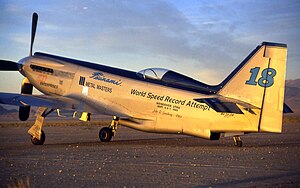Tsunami (aircraft)
| Tsunami | |
|---|---|

| |
| Role | Racing aircraft |
| National origin | United States |
| Designer | Bruce Boland John R. Sandberg Pete Law Ray Poe |
| First flight | August 17, 1986 |
| Primary users | John R. Sandberg Steve Hinton Skip Holm |
| Produced | 1986 |
| Number built | 1 |
Tsunami was an experimental purpose-built racing aircraft designed and built in the United States during the 1980s. After a short undistinguished career Tsunami crashed, killing its designer, John Sandberg, on 25 September 1991.
Design and development
After 6 long years of building the aircraft was first flown 17 August 1986 by test pilot Steve Hinton, was designed specifically to break the 3 km world speed record for propeller driven aircraft by a private pilot and to compete in the Unlimited class at the Reno Air Races.[1][2][3][4] The aircraft was designed by Bruce Boland an aerospace engineer employed by Lockheed Martin, John R. Sandberg owner of JRS Enterprises Inc, that rebuilt Allison, Rolls Royce, Merlin aircraft engines along with Lockheed engineer Pete Law and builder Ray Poe. Tsunami, powered by a Rolls-Royce Merlin engine, designed and built by John R. Sandberg and the JRS Enterprise Inc. team, exceeded 500 mph (430 kn; 800 km/h).[1]
Originally, it was designed as a light-weight racer with a single-staged supercharged Rolls-Royce Merlin. However, as speed increased in the Unlimited Racing Class, a higher powered two-stage supercharged Rolls-Royce Merlin was installed. An attempt was made in August 1989 to break the 3 km (1.9 mi) world speed record at Wendover Utah with a private pilot at the controls. Due to a landing gear collapse the aircraft was unable to beat the existing record.[1]
Operational history
Despite being very fast, in its racing career from 1986 to 1991 it only won one Unlimited Gold Race, in Sherman, Texas in 1990.
Fatality
The program ended in 1991 when the owner John Sandberg lost his life while ferrying the aircraft home. The NTSB report states that the airspeed indicator was off and a mechanical failure in the flap system, causing the aircraft to roll on final approach into Pierre, SD on 25 September 1991.[5][6][7]
Specifications (Tsunami)
Data from [8]
General characteristics
- Crew: 1
- Length: 28 ft 6 in (8.69 m)
- Wingspan: 27 ft 6 in (8.38 m)
- Airfoil: NACA 63-212 modified
- Empty weight: 5,100 lb (2,313 kg)
- Gross weight: 7,000 lb (3,175 kg)
- Fuel capacity: 110 US gal (92 imp gal; 420 L)
- Powerplant: 1 × Rolls-Royce Merlin race modified V-12, 3,000 hp (2,200 kW)
Performance
See also
Aircraft of comparable role, configuration, and era
References
- ^ a b c "The Tsunami Project - Home". rebuildtsunami.org. Retrieved 30 September 2017.
- ^ Tegler, John (August 1980). "New Unlimited Racer Under Construction". Air Classics. 16.
- ^ Wallace, Lane (December 2009). "Tsunami Rises Again?". Flying Magazine.
- ^ Patton, Tom. "Rebuilding A Legacy". Aero Tv. Retrieved 5 May 2011.
- ^ Cox, Jack (May 1983). "Tsunami". Sport Aviation.
- ^ Cox, Jack (December 1986). "Tsunami". Sport Aviation.
- ^ Hoffman, Carl (August 2004). "Wingtip TO Wingtip At 450 mph 30 Feet Above The Ground Sideways". Popular Science.
- ^ "Tsunami". The Tsunami Project. Retrieved 30 September 2017.
